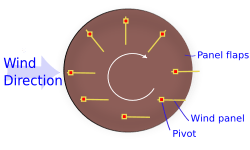Panemone windmill
A panemone windmill is a type of vertical axis wind turbine. It has a rotating axis positioned vertically, while the wind-catching blades move parallel to the wind. By contrast, the shaft of a horizontal axis wind turbine (HAWT) points into the wind while its blades move at right-angles to the wind's thrust. That is, a panemone primarily uses drag whereas the blades of a HAWT use lift.[1]

Historically the earliest known wind machine was made by the Persians and it was the panemone design, consisting of a wall, with slits, surrounding a vertical axle containing four to eight fabric sails. As the wind blew, the sails would turn the axle, which was in turn connected to grain grinders or some form of water transportation device (though little is known of the actual details of such methods).[2]
History

The earliest recorded windmill design found was Persian in origin, and was invented some time around 700–900 AD.[3][4] This design was the panemone, with vertical lightweight wooden sails attached by horizontal struts to a central vertical shaft. It was first built to pump water, and subsequently modified to grind grain as well.[1] Wind-powered machines may have been known earlier, but there is no clear evidence of windmills prior to the 9th century.[5]
A legendary account of the windmill attributed its invention to Pīrūz Nahāvandi. Before becoming a slave to Rashidun caliph Umar, Nahāvandi was said to have designed and built windmills. In the 9th century, he brought a complaint to Umar about the high tax charged to him by his master Mughirah. Umar wrote to Mughirah and inquired about the tax; Mughirah's reply was satisfactory, but Umar held that the tax charged from Abu Lulu was reasonable, owing to his daily income. Umar then is reported to have asked Abu Lulu to design a windmill for him, in which Pīrūz replies, "By God, I will build this [wind]mill of which the World will talk".[6] However, this account may have been a 10th-century amendment.[7] The first clear evidence of vertical-axle windmills are dated to the 9th century, in the Persian region of Sistan (modern Iran and Afghanistan), as described by Muslim geographers.[8] The windmill became widespread across the Islamic world, and later spread to India and China.[9]
Operation
The vanes of a panemone are moved by the wind in a circle to turn the drive shaft. To accomplish this they must move with the wind only while on one side of the circle, and move against the wind on the other side. To prevent the vanes moving upwind from being blown back by the wind, one half of the panemone may be shielded, or else the vanes may be attached so that they can turn edge-on to the wind when the wheel is moving them upwind.[1]
Efficiency
Wind-harnessing devices which rely on drag reach their maximum efficiency if the collector is pushed away from the wind. Because the wind panels do no work while returning to the upwind side of the device, the rotor in the Persian panemone design can only take energy from wind striking half the collection area (see diagram).
The panemone is one of the least efficient types of wind turbine. Despite this it is also one of the most commonly re-invented and patented forms.[1][10]
See also
References
- "Part 1 — Early History Through 1875". Retrieved 2008-07-31.
- "How is a windmill made?". Retrieved 2008-08-01.
- Eldridge, Frank (1980). Wind Machines (2nd ed.). New York: Litton Educational Publishing, Inc. p. 15. ISBN 0-442-26134-9.
- Shepherd, William (2011). Electricity Generation Using Wind Power (1 ed.). Singapore: World Scientific Publishing Co. Pte. Ltd. p. 4. ISBN 978-981-4304-13-9.
- Shepherd, Dennis G. (December 1990). "Historical development of the windmill". NASA Contractor Report. Cornell University (4337). CiteSeerX 10.1.1.656.3199. doi:10.2172/6342767.
- RJ Forbes. Studies in ancient technology. Vol. 9. Brill, 1964.
- Dietrich Lohrmann (199786543). "Von der östlichen zur westlichen Windmühle", Archiv für Kulturgeschichte 77 (1), p. 1-30 (8).
- Ahmad Y Hassan, Donald Routledge Hill (1986). Islamic Technology: An illustrated history, p. 54. Cambridge University Press. ISBN 0-521-42239-6.
- Hill, Donald (2013). A History of Engineering in Classical and Medieval Times. Routledge. p. 173. ISBN 9781317761570.
- "A Panemone (Drag-Type Windmill)". Archived from the original on 2008-10-25. Retrieved 2008-07-31.